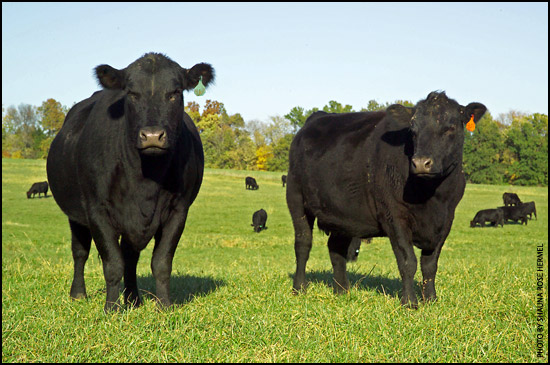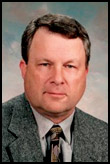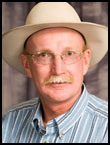MANAGEMENT...
SPECIAL SECTION – Focus on Reproduction

When it comes to reproduction,
The Little Things Matter
Why can beef herd pregnancy rates vary so much? What causes the variation? The answer lies in management, says George Perry, assistant professor in beef reproductive management at South Dakota State University. “Management can affect the outcome of artificial insemination (AI) or natural-service breeding,” Perry commented. “Little mistakes can add up to a big impact on fertility.” Read more.
Factors Affecting Fertilization
Whether or not cattlemen are using synchronization protocols in beef cattle breeding programs, “the rules of biology” still have to be followed in order to achieve fertilization, Richard Saacke, Virginia Tech professor emeritus, said.
Saacke emphasized that the bottom line in successful insemination and fertilization comes down to sperm transport in the cow.
During insemination, timing is critical. Research suggests that if you breed too early, fertilization rates tend to be low, but embryo quality is high. Conversely, if you breed too late, fertilization rates may be high, but embryo quality tends to be lower due to the aging eggs. Read more.
Bull Management Considerations
It isn’t new, and it isn’t rocket science, but understanding the dynamics of bull fertility and management of breeding bulls is fundamental to sustaining a successful breeding herd. During the Robert E. Taylor Memorial Symposium in Fort Collins, Colorado State University (CSU) Extension Veterinarian Roger Ellis said the fundamental goals of natural service breeding programs are threefold:
• Achieve the highest possible pregnancy rates early in the breeding season.
• Produce the highest possible number of calves from bulls of the greatest genetic merit.
• Achieve the previous goals as efficiently as possible.
What We Know About Fetal Programming
When managers of cow herds ponder nutrition programs, a primary concern is the fueling of optimum reproduction. Cow-savvy managers know that quantity and quality of feed sources influence the cow’s ability to breed in a timely fashion and deliver a healthy, vigorous calf.
The cow’s nutritional status during those later months of pregnancy also influences how quickly a cow’s reproductive system recovers postpartum and resumes normal estrous activity. It’s hard to get a cow ready to breed if she was in sorry shape at the time of calving. Read more.

Bill Beal
Repro Tracks
Contract recipient herds for embryo transfer
Angus breeders who use embryo transfer (ET) often contract with owners of commercial cow herds for recipients to raise their ET calves. This provides the opportunity for commercial cow-calf operators to add value to their weaned calf crop. However, every agreement between an embryo owner and the contract recipient herd owner should be crafted carefully and underpinned by a legal contract that clearly spells out the expectations and responsibilities of each party. Read more.

Kris Ringwall
Beef Talk
Calving date equals latitude and altitude
As cow-calf producers, we understand where we live, but when we seek advice, we often seek that advice from those who live elsewhere.
As with any major change within a beef operation, each change needs to be thought out and penciled through. Recently, the bull turnout and subsequent calving date have been the focus of considerable discussion. Read more.
Calf-Fed or Yearling Production Systems?
High feed costs took their toll on Nebraska cattle producers last year, and with the uncertainty of this year’s prices, many are looking at ways to cut costs.
One way to reduce high feed costs is to look at how calves are finished — either in calf-fed or yearling production systems. However, recent analysis from University of Nebraska-Lincoln (UNL) livestock economist Darrell Mark and UNL graduate student Becky Small found there hasn’t been much difference between the two on average across several years, but the difference can be substantial in each year. Read more.
Harvesting the Wind
There are days when the wind blows fast and long at Wagon Wheel Ranch of Yuma, Colo. On those days, owner Kenny Rogers glances skyward, fixing his eyes on a set of rotating black cups mounted nearly 70 feet (ft.) above on a large antenna. The cups, which measure wind speed, are connected to a control box near the ground where wind data is continuously logged into a removable storage chip. Rogers installed the wind-monitoring equipment before Christmas 2008. By December this year, 12 full months of wind speed and directional data will have been collected, and Rogers will know more precisely what his wind resource is — and its potential economic value. Read more.

Ron Torell
Back to Basics
The cattle industry’s glass is half full.
Those of us in the agriculture industry are generally glass-half-full type of people. Our optimism is now being tested. Expenses are gaining ground. Input costs for raw materials such as feed, fertilizer and parts have all skyrocketed to unbelievable levels, and there appears to be no end in sight. Being a glass-half-full type of person, what are you to do? Read more.
BIF Meeting Concludes in California
Genomics took center stage at the 2009 Beef Improvement Federation (BIF) annual symposium in Sacramento, Calif., April 30-May 3. The event was hosted by the California Cattlemen’s Association and the California Beef Cattle Improvement Association.
Angus Productions Inc. (API), in partnership with BioZyme Inc., provided coverage of the event, available at www.bifconference.com.
Visit the site’s Symposium Papers page for abstracts and proceedings; the Newsroom summaries, audio files and PowerPoints; the Awards page for news releases on award winners; and the Photo Galleries page for coverage of the the tours.
Mark your calendar for June 28-July 1, 2010, for next year’s meeting, which will be hosted in Missouri.





